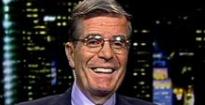Matt Scully Remembers Ted Sorensen
 Matt Scully wrote (posted on October 31st, 2004):
Matt Scully wrote (posted on October 31st, 2004):
Should John F. Kerry win this election, his speechwriters will set about preparing for Jan. 20 by studying the inaugural addresses of the presidents, and like others before them, they will discover that there is not much there to instruct or inspire. Most inaugural speeches are on the overwrought side, straining a little too hard for drama and history. Of 54, only two achieved something like perfection -- Abraham Lincoln's in 1865 and John F. Kennedy's in 1961.
We know why Lincoln's second inaugural address turned out so well: because Lincoln wrote it. But it takes a little convincing before we conclude, as Thurston Clarke argues in "Ask Not: The Inauguration of John F. Kennedy and the Speech That Changed America," that JFK's speech was great because JFK wrote it.
The book, Clarke's 10th, is a fascinating account of the 10 days in which the speech came together. It has always been assumed that although only Kennedy could have gotten up there and read the words as he did, the composition, and certainly the finer flourishes, must have come from speechwriter Ted Sorensen and the dozen or so other bright lights of the New Frontier, including Adlai Stevenson and John Kenneth Galbraith, who contributed lines or advice. Sorensen is still revered by speechwriters, both for his superior skill and his example of noble silence (the speechwriter as celebrity credit hound would come later). No one has ever quite believed him when he called Kennedy the principal author of the address.
According to Clarke, this is not false modesty after all. On Jan. 10, Sorensen submitted a capable draft but it contained little we would recognize. With that draft in hand, Kennedy sat down aboard his private jet, en route to Palm Beach, and to his secretary Evelyn Lincoln dictated passages that include such phrases as "hour of maximum danger," "long twilight struggle" and "let the word go forth."
He had inspirations like this, "moments of grace," we are told, when the words flowed. In this case, Clarke tells us, "most of the words chiseled into that curving wall at Arlington appeared for the first time, not in [Kennedy's] handwriting or in Ted Sorenson's, but in the lines, loops, and squiggles of [Evelyn] Lincoln's shorthand."
This scene aboard the Caroline becomes plausible as the collaboration continues in Palm Beach -- Sorensen turning in new drafts, Kennedy "re-dictating" those in his own words and so on, back and forth. Their working material throughout was a collection of themes, images, evolving phrases and Churchillian constructions JFK had developed since his youth, particularly in extemporaneous speeches from which Sorensen drew heavily before adding his own distinctive polish.
Twilight struggles, the summoning of trumpets and other familiar phrases and images can all be found, in various iterations, in earlier Kennedy speeches spoken without a text. As for the calculated master sentence of the inaugural, the admonition of Kennedy's prep school headmaster -- to ask "not what Choate does for you, but what you can do for Choate" -- pretty much settles its origin.
The best evidence of Kennedy as the "controlling intelligence" of the speech is seen in Clarke's comparison of the final prepared text with the "as delivered" version. Incredibly, JFK made another 32 edits as he read the speech -- from "cold and bitter peace," for instance, to "hard and bitter peace" -- and all of them, says Clarke, "rendered his sentences tighter or smoother."

